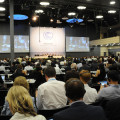What to Look for in the Paris Package
Hamish M | December 2, 2015.
The Verb’s Negotiation Compass has outlined four broad scenarios that may come out of the Paris talks. The best-case scenario, Full Throttle, commits nations to significant short-term action and lays the foundation for future ramp up. Two mid-range scenarios involve trade-offs being made: a Hare scenario would involve only short-lived progress, whilst a Tortoise would avoid short-term commitments but lay the path for future commitment. In the worst case, Trainwreck, the agreement would contain neither immediate action nor any promise of future action.
Which of these broad outcomes materialises, ultimately depends on painstaking negotiations over the details of the text. Across the seven key issues that the agreement must address, we have outlined what language to look for, and perhaps more importantly, what kind of language might signal backsliding towards Trainwreck territory. This guide is your cheat-sheet to the negotiations.
Full Throttle
Short-term mitigation: INDCs are anchored in the text with strong language around “preparing, communicating and implementing” them, and pre-2020 commitments are included in the treaty.
Ratchet-up mechanism: Five-year review cycles with clear language around “upscaling” or “strengthening” ambition, and mitigation, adaptation, loss and damage, and finance areas all mentioned explicitly. A start date of 2018 proposed.
Long-term goal: Clear language around “decarbonisation of the global economy by 2050”, accompanied by a differentiated timeline for developed and developing countries, and reference to the pace as well as the date of decarbonisation.
Transparency and accountability: Language refers to a single “common framework” for measuring, reporting and verification (MRV) to be implemented by 2020 with a developing nation grace period, and a new independent body established to review the progress of parties.
Finance: Five-year review cycles, explicit language around a “scale-up” or “increase” from the $100bn floor and a clear commitment to continue to flow of funding beyond 2020, until the point of decarbonisation. Finance linked to adaptation and reference to the most vulnerable countries.
Adaptation: Creates a high-level forum to administer five-year review cycles of adaptation commitments and a clear directive to allocate half of committed public finance to adaptation.
Loss and damage: Reference to loss and damage included in the core instrument with explicit reference to the Warsaw Mechanism (WIM). Could include language limiting liability and compensation so long as it is included in the first place.
The Tortoise
Short-term mitigation: Pre-2020 mitigation commitments are excluded from the core text, but the INDCs are well anchored with language around “preparing and communicating” them.
Ratchet-up mechanism: Five-year review cycles with clear language around “upscaling” or “strengthening” ambition, but no explicit start date mentioned. Adaptation, finance and loss and damage referenced vaguely.
Long-term goal: language around “decarbonisation of the global economy”, or slightly weaker “zero emissions” with a deadline of “mid-century” or at worst “late century”. Accompanied by a differentiated timeline for developed and developing countries.
Transparency and accountability: Language refers to a single “common framework” for MRV to be implemented, but only by 2030. Developing nation grace period and a new independent body established to review the progress of parties but no start date mentioned.
Finance: Few extra finances pledged leaving significant shortfall of funds, but commits to “scale-up” or “increase” or “strengthen” financing after 2020, with no mentions of a baseline. Leaves countries in the lurch with a promise of future funds.
Adaptation: Creates a high-level forum to administer five-year review cycles of adaptation commitments, but has no clear start date or a start date of 2025-2030, and no mention of linking finance with adaptation cycles.
Loss and damage: Included in core agreement but not framed as loss and damage, phrased instead along the lines of “addressing irreversible impacts”. A COP decision on the Warsaw Mechanism keeps hope alive that finances may start to flow in the future.
The Hare
Short-term mitigation: INDCs are anchored in the text with strong language around “preparing, communicating and implementing” them, and pre-2020 commitments are included in the treaty.
Ratchet-up mechanism: Largely excluded from the text. INDCs presented only as a solution for the 2020-2030 period, with weak upscaling plans. May make vague reference to “review” or “re-submit” INDCs after five or tens years.
Long-term goal: Weak language around “climate neutrality” or “near zero” or “low carbon economy” and vague target date such as “towards the end of the century”. Provides little certainty beyond 2030.
Transparency and accountability: Requires countries to report on their INDC progress but fails to establish strong mandate for a common framework for MRV. Language is instead around “convergence of frameworks” and “before 2030” nominated as the date. Provides short-term mandate for clear reporting as much as possible, but little assurance that a common MRV framework will emerge to facilitate transition to decarbonisation.
Finance: Strong commitments to meet the $100 billion target for 2020, but only vague references to any future funding. Language commitment to “review” or “re-submit” financing commitments post-2020. Adaptation and loss and damage excluded from finance.
Adaptation: Recognises importance of adaptation by committing to direct half of pre-2020 public finances, but fails to establish strong review cycles post-2020.
Loss and damage: Commitment of some funds to compensate the most vulnerable countries as part of pre-2020 finance, but Warsaw Mechanism excluded from the text, and explicit refusal of long-term liability for compensation.
The Trainwreck
Short-term mitigation: Pre-2020 commitments excluded from the agreement, INDCs loosely anchored with commitment only to “prepare and communicate”, with no requirement for implementation.
Ratchet-up mechanism: Weak language that lacks direction such as commitments only to “re-submit” or “review” commitments every 10 years, and no reference to finance or adaptation. Provides little support for future acceleration of ambition.
Long-term goal: Weak language around “climate neutrality” or “near zero” or “low carbon economy” and vague target date such as “towards the end of the century”. Provides little certainty beyond 2030.
Transparency and accountability: Would allow multiple accounting standards and no momentum for the emergence of a common framework. Compromises the integrity of INDCs and all subsequent commitments.
Finance: Few extra funds pledged towards the pre-2020 target leaving a significant shortfall, and only vague references to future funding. Language commits only to “review” or “re-submit” financing commitments post-2020. Adaptation and loss and damage excluded from finance.
Adaptation: Language focusses on a generic vision to ‘build resilience’ with no effort to link adaptation plans with mitigation, or to upscale adaptation ambition in the future.
Loss and damage: Language acknowledges loss and damage in the preamble only, no mention of the Warsaw Mechanism, and no funds pledged.
State of Play
We will be posting daily updates on the state of play using the Compass to assess the progress, or otherwise, of the negotiations. Check back to see how the talks are tracking.













comment